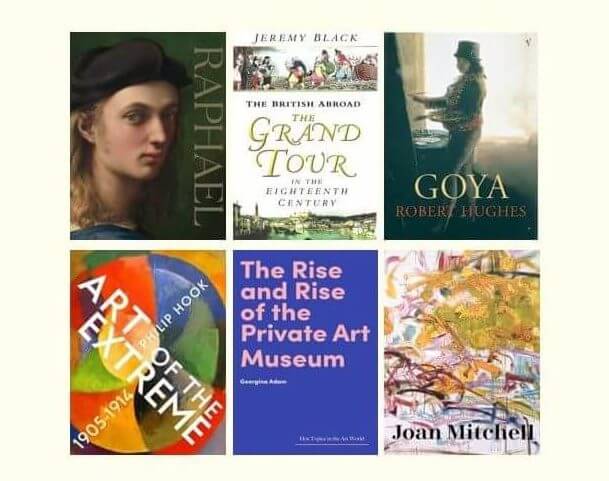James Roundell, Director, Impressionist & Modern Art:
Art of the Extreme 1905 – 1914 by Philip Hook, Profile Books Limited, 2001
We can always count on Philip Hook for an entertaining read, and Impressionist and Modern department director James Roundell recommends the latest offering by Hook, author of Breakfast at Sotheby’s and Rogues’ Gallery. In Art of the Extreme: 1905 – 1914, Hook presents the case for considering the decade leading up to the First World War to be the most significant and eventful in all of Modern art if not art history in its entirety. Cubism, Futurism, Expressionism, Fauvism, and Abstraction, among other landmark movements, appeared during this decade, and its relevance for art dealing and the use of art as propaganda were equally impactful. If you’re a Modernist, this is one not to miss.
Janelle Diethelm, Gallery Administrator, New York:
The British Abroad: The Grand Tour in Eighteenth Century by Jeremy Black, 2020 ed., Sutton Publishing Ltd., 1992
Jeremy Black’s The British Abroad: The Grand Tour in Eighteenth Century is an incredible resource for academics and Grand Tour enthusiasts alike. Utilizing countless primary sources, Black brings to life the experiences of British travelers in Europe. The Grand Tour was a complicated and not always glamourous adventure. Issues of low funds, uncomfortable modes of transportation, and other nightmarish experiences plagued travelers; however, culinary delights, wild parties, and magnificent art collections rewarded those willing to take the journey. This comprehensive resource is a wonderful read and a welcome addition to my library.
Fraser Short, Old Masters Administrator:
Goya by Robert Hughes, Harvill Press, 1st Ed., 2003
Robert Hughes depicts Goya as the court painter who tried to drag a superstitious Spain into the humanism and rationalism of the Enlightenment. The tragedy of Goya’s story, as Hughes describes it, is that he failed and he knew it. The reader is invited to understand Goya as a man and an artist. A mysterious illness that left him deaf at 46 is pinpointed as provoking a sea-change in his style. The pain and loss detectable in some of Goya’s later works (The Disasters of War, The Black Paintings) have no precedent in art history. Struggle, war, triumph and defeat are rife in Goya’s life and Hughes invites us not only to empathise but to relate personally to this character. Hughes hits the nail on the head time and again with his highly readable prose and savvy insights into 18th Century Spain, the failed promises of the Enlightenment, and Goya himself.
Lilly Dawson, Senior Sales Associate:
Joan Mitchell by Sarah Rehm Roberts, ed., Katy Siegel, ed., Paul Auster, Yale University Press, 2022
A wonderful and generous friend recently gifted me the beautiful monograph Joan Mitchell published in tandem with the comprehensive retrospective co-organized by San Francisco Museum of Modern Art and the Baltimore Museum of Art (on view until 14 August and traveling to the Fondation Louis Vuitton from 5 October). Featuring over 80 works, the exhibition follows the artist’s career from her first critically acclaimed presence in 1950s New York through her nearly four decades in Vétheuil, France. Her dynamic abstractions were inspired by landscapes, memories, poetry, music – beautifully highlighted with primary source materials – as well as her personal confrontation with the social dynamics of the times and her quest for artistic freedom. The catalogue is the first major scholarly publication on Mitchel in decades. Despite the heft that 384 pages may pose to and from the beach, pool or porch – one I’m willing to manage – I look forward to diving into the various essays by co-curators Sarah Roberts and Katy Siegel, and scholars Eric de Chassey, Jenni Quilter, and Richard Shiff for their groundbreaking research and fresh perspectives on Mitchell’s dynamic and complex work.
Molly Dorkin, Associate Director and Head of Research:
Raphael by Matthias Wivel, ed., David Ekserdjian, Tom Henry et al., exh. cat., Yale University Press, 2022
When we think of Raphael we immediately picture his sublime Madonnas and elegant portraits, or perhaps the majestic frescoes in the Vatican. But Raphael as architect and poet, or the designer of prints? Those achievements are less widely known outside Renaissance art circles. The National Gallery’s comprehensive, career-spanning exhibition seeks to explore all the facets of Raphael’s brief and dazzling career, and the accompanying catalogue, edited by curator Matthias Wivel and featuring contributions from David Ekserdjian, Thomas P. Campbell, Caroline Elam and others, celebrates Raphael’s varied achievements and interests alongside illustrations of works lent by the Louvre, Prado, Uffizi and many other international collections.
Lilly Dawson, Senior Sales Associate, and Molly Dorkin, Associate Director and Head of Research:
The Rise and Rise of the Private Art Museum by Georgina Adam, Sotheby’s Institute of Art, 2021
Art market journalist Georgina Adam takes us behind the scenes of the private art museum and its rise in the 21st Century in her latest book, with thorough research based on visits to 50 such institutions around the world. There are currently some 400 private museums, of which 70% are dedicated to Contemporary art, and this begs the question: why a private museum? Are they purely vanity projects, are they tax schemes, or do they represent something else entirely? And what is – or should be – their relationship to public institutions? These are all questions Adam tackles in The Rise and Rise of the Private Art Museum, a book that Dickinson definitely recommends to anyone who’s ever daydreamed of his or her own museum.


